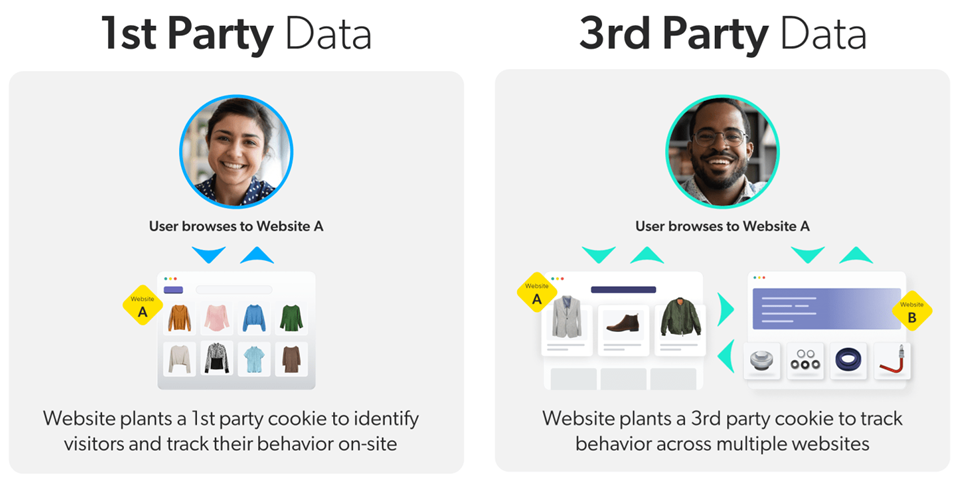Preparing for Cookieless Future in 2024 Using Robust Data Network & Gen AI
Introduction
In January 2024, Google’s announcement regarding the deprecation of third-party cookies on Chrome sent shockwaves across the digital realm. This decision, echoed by other major browsers like Apple’s Safari and Mozilla Firefox, raises profound questions for marketers and consumers alike.
Consider this–Third-party cookies have long been the silent trackers of our online browsing or purchasing behavior, shaping the ads we see and the products we consider. With their imminent disappearance, how will marketers adapt to this new landscape? And more importantly, what implications does this hold for your online privacy and user experience?
In a recent report by Statista1 it was revealed that a staggering 75% of marketers heavily rely on data gathered by third-party cookies to inform their campaigns and advertising strategies. The pertinent question is how will companies leverage AI and other innovative technologies to continue reaching their target audience effectively? This will bring a fresh set of challenges for companies that rely heavily on third-party cookies to track consumer’s preferences to target them in a cookieless future. As a result, companies are actively looking out for alternative strategies that can fill the gap created by third-party cookies and augment targeting their consumers in a cookieless future with AI.
Internet cookies and their type
Internet cookies, those small text files deployed on a user’s device by websites, play a crucial role in tracking online activities to enhance future user experiences. These cookies come in two types:

- First party cookies
Collected by websites or portals for users visiting them, first-party cookies capture and store login information, preferences, searches within the site, items in cart, and checkout information.
- Third-party cookies
These cookies gather information about users’ activities on websites other than the one they are visiting. Their purpose is to understand user preferences and overall behavior to offer matching content and services. However, they also enable advertisers to place ads tailored to users’ behavior and preferences, generating revenue.
Changes due to deprecation of third-party cookies in marketing
Deprecation of third-party cookies will lead to several direct and indirect changes in marketing. However, two of the major changes are as follows:
- Decreased tracking capabilities
With the majority of browsers deprecating third-party cookies, tracking consumer behavior will become challenging for advertisers. This will impact consumer packaged goods (CPGs) companies aiming to target potential customers through relevant ads. According to a recent survey by GetApp2, around 41% of marketers believe their biggest challenge will be the inability to track the right data.
- Shift in advertising strategies
As tracking capabilities diminish, marketers will be prompted to explore cookieless solutions for understanding consumer preferences. This shift will necessitate a change in marketing strategies to adapt to a cookieless world. A report by Statista3, indicates that nearly 60% of marketers are either accelerating their readiness for a cookieless future or keeping it as a high priority.
Preparing for a cookieless future in 2024
In preparation for a cookieless future in 2024, marketers are exploring sustainable alternatives to fill the gap created by third-party cookies. They are enhancing the utilization of existing data sources for more impactful targeting.
Some of the key alternatives to fill the gap for third-party cookies are:
- Building a robust network of first-party data
- Utilizing privacy application programming interfaces (APIs) for retargeting
- Augmenting visibility on the web
Once data from these alternatives are sourced, marketers must focus on key elements for customer engagement in a cookieless future with AI. The elements include:
- Personalized targeting
- Contextual targeting
- Interactive marketing
According to a survey by Segment4, 56% of consumers say they will become repeat buyers after a personalized experience, and 92% of companies are using AI-driven personalization to drive business growth. A study by GumGum5 found that contextually relevant ads generated 43% more neural engagement and 2.2 times better ad recall, and they were 10% more engaging than the article content overall.
These findings underscore the importance of leveraging AI to deliver personalized and contextually relevant marketing experiences, helping businesses adapt to the challenges of a cookieless future.
Future of customer targeting
The customer targeting process begins with listing the product stock-keeping units (SKUs) and geographic regions for targeted customers. The brand manager then identifies the most relevant keywords to position their product in the market and creates a list of key competitors. Once all this information is available, data can be procured from various platforms, including first-party data (both online and offline), privacy APIs from search engines and social media, SEMrush, and market and competitor trends.
This data is then integrated and analyzed to derive insights around key themes, emerging trends, and whitespaces. Primary and secondary keywords are identified for use in customer targeting.

Using these keywords and brand guidelines, personalized content and graphics for ads, mailers, and SEO-compliant product pages are created with the help of Gen AI.
Personalized targeting
Gen AI can generate a target audience database using algorithms like LiveRamp and the Identity Resolution Engine, drawing from first party sources such as websites, product pages, partner ecommerce sites, customer data platforms (CDPs), surveys, customer feedback on the web and social media, and hyperlocal market intelligence. Gen AI can then select the most appropriate templates based on users’ demographic, geographic, and linguistic preferences, and trigger personalized campaigns through direct mailers, promotions, early accesses via partner ecommerce sites, and web and social media platforms. It will also recommend updates to the product page content according to geographic user preferences.

Contextual targeting
Gen AI can identify relevant webpages based on primary and secondary keywords and further scrutinize these pages using factors like search engine ranking, content and context of the pages, page security (SSL), and unique hits. Once the relevant URLs are finalized, Gen AI will automatically select the most appropriate themes, content and graphics from the repository for ads, and position them on the webpages using tools like Google Ads Manager and Meta Business Manager.

Interactive marketing
Gen AI can support the integration of interactive chat modules on websites and social media handles to extend personalized engagement with customers using large language models (LLMs). Brand managers can monitor all campaigns and communications triggered by them using Gen AI. It will capture customer engagement and transactions from these campaigns to determine their effectiveness and recommend retargeting strategies.
Conclusion
The deprecation of third-party cookies will significantly impact the tracking of consumers behavior, compelling companies that relied heavily on third-party data to shift their marketing strategies. Identifying and implementing alternatives to fill the gap left by third-party data, along with measures to enhance these new strategies is crucial.
Gen AI can augment these strategies by combining data engineering, machine learning, and language models to assimilate data from diverse sources and understand consumers’ personal preferences. Studies suggest that most consumers prefer personalized experiences. Gen AI can help implement these personalized experiences with target consumers. For businesses, knowing the effectiveness of their various targeting activities is equally important. Gen AI offers the capability to monitor these activities and provide real-time insights.
LTIMindtree collaborates with several CPG companies, leveraging Gen AI to create a deeper understanding of consumer behavior through data, enabling personalized engagements, and helping businesses monitor their effectiveness in real time.
For more information, please reach out to: solutions.EAIadvisory@ltimindtree.com
Citations:
1 Third-party cookie deprecation – statistics & facts, Statista Research Department, May 28, 2024: https://www.statista.com/topics/7693/third-party-cookie-deprecation/#topicOverview
2 The Death of the Third-Party Cookie: What Marketers Need to Know About Google’s 2023 Phase-Out, Pamela Bump, July 27, 2022: https://blog.hubspot.com/marketing/third-party-cookie-phase-out
3 Third-party cookie deprecation – statistics & facts, Statista Research Department, May 28, 2024: https://www.statista.com/topics/7693/third-party-cookie-deprecation/#topicOverview
4 The State of Personalization Report 2023, Twilio Segment, April, 2023: https://segment.com/state-of-personalization-report
5 The new contextual ad targeting works, study says, Ginny Marvin, March 26, 2020: https://searchengineland.com/the-new-contextual-ad-targeting-works-study-says-331574
Latest Blogs
Core banking platforms like Temenos Transact, FIS® Systematics, Fiserv DNA, Thought Machine,…
We are at a turning point for healthcare. The complexity of healthcare systems, strict regulations,…
Clinical trials evaluate the efficacy and safety of a new drug before it comes into the market.…
Introduction In the upstream oil and gas industry, drilling each well is a high-cost, high-risk…




